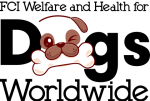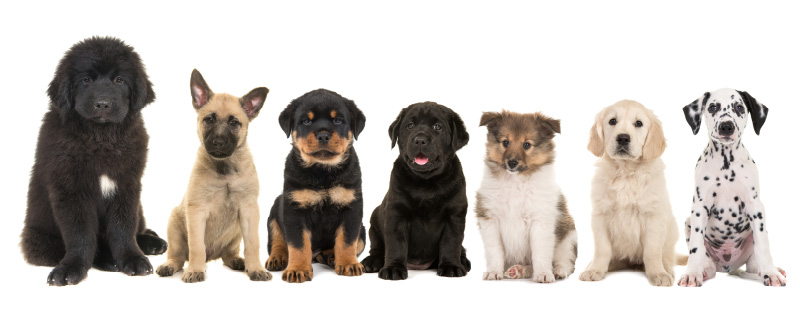
PREPARING AND CARING FOR YOUR PUPPY
Dogs have been domesticated for thousands of years and their position in our society has evolved from being valued for the tasks they performed to assist humans (farm dogs, guard dogs, etc) to being that of our faithful and cherished companions. The value of this special and unique companionship that dogs bring, is now well established, and recognised, with dog ownership in some countries being as high as 75%. Recent studies have also shown evidence- based health benefits of owning a pet and dogs are the leading species supporting humans through animal assisted therapy.
The benefits to owners of having dogs as part of their lives does however come with an equally significant responsibility, duty of care and safeguarding both their pet’s mental and physical health and welfare that goes beyond just meeting their basic needs. There is also a moral obligation too, not just to your dog but to the society around you that your dog will be a part of.
So, the long-term commitment of getting a dog should never be taken lightly. Being prepared and doing your part is also vital to ensuring this partnership is a lifelong one and doesn’t end up as a shelter story, because of a lack of preparedness or having failed to properly assess the level of commitment required to care for a dog. Remember we choose to have pets join our homes and not the other way around, so we have the greater task of ensuring we are prepared and fully committed to taking care of our pets for their entire life.
PREPARING FOR YOUR PUPPY
It is crucial to have your home prepared for the arrival of your new puppy, particularly as their initial experiences in their new environment may impact and form their future behaviour. It is therefore important that your puppy feels reassured and protected in their new home, so that they can express their natural puppy behaviours and learn what is expected of them. As robust and hardy as puppies may appear, this change of environment can be stressful for them due to new smells, sounds, sights and not to mention being all alone without the reassurance of their littermates and mother, with whom they have spent their early days. Your preparation and reassurance will help them to settle in more easily and adjust to their new surroundings.
As part of this an important consideration is the equipment you will need in preparing for the arrival of your new puppy.
Essential Equipment
It is crucial to have your home prepared for the arrival of your new puppy, particularly as their initial experiences in their new environment may impact and form their future behaviour. It is therefore important that your puppy feels reassured and protected in their new home, so that they can express their natural puppy behaviours and learn what is expected of them. As robust and hardy as puppies may appear, this change of environment can be stressful for them due to new smells, sounds, sights and not to mention being all alone without the reassurance of their littermates and mother, with whom they have spent their early days. Your preparation and reassurance will help them to settle in more easily and adjust to their new surroundings.
As part of this an important consideration is the equipment you will need in preparing for the arrival of your new puppy.

Food bowl
A clean food bowl placed in an area where your dog will be fed each day is a necessity. It is advisable to get something practical and long lasting, that will be safe for your pup such as a metal bowl.
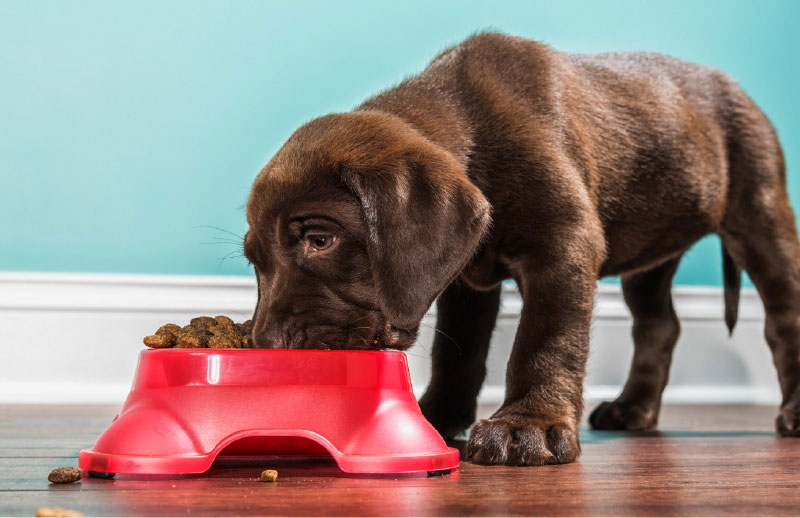

Water bowl
It is important for your pup to have a separate water bowl so that they always have constant access to fresh water, having a dedicated area where the water bowl is placed will also help your pup know where the bowl is and what it contains.
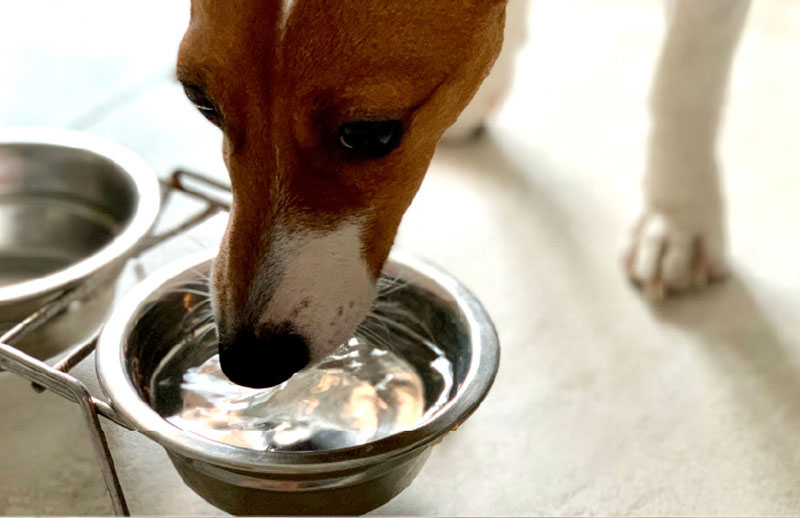

Collar or Harness
As daily walks will be part of your pup’s life, the great debate of what you should use – collar or harness is important to consider, especially in terms of the size of your dog.
Collar
A good collar needs to fit well around your puppy’s neck leaving space for about two fingers for optimal comfort. Choke, pinch and shock collars should never be used and in some countries are illegal.
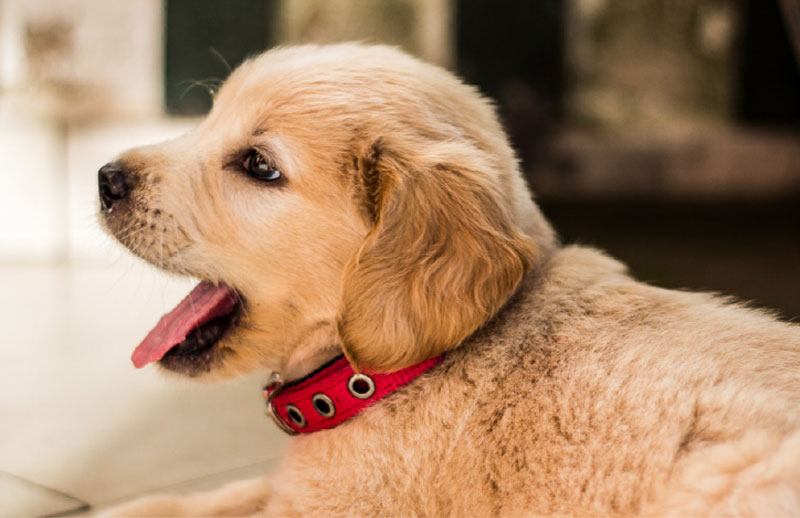
Harness
A harness is often recommended for walks – they are less stressful on a puppy’s body as the pulling pressure is distributed evenly,rather than on their delicate necks. To ensure your pup is comfortable, you should be able to pass two fingers snugly between the harness and your dog’s body. A reliable pet store will be able to help you choose the correct harness and ensure it fits your puppy safely.
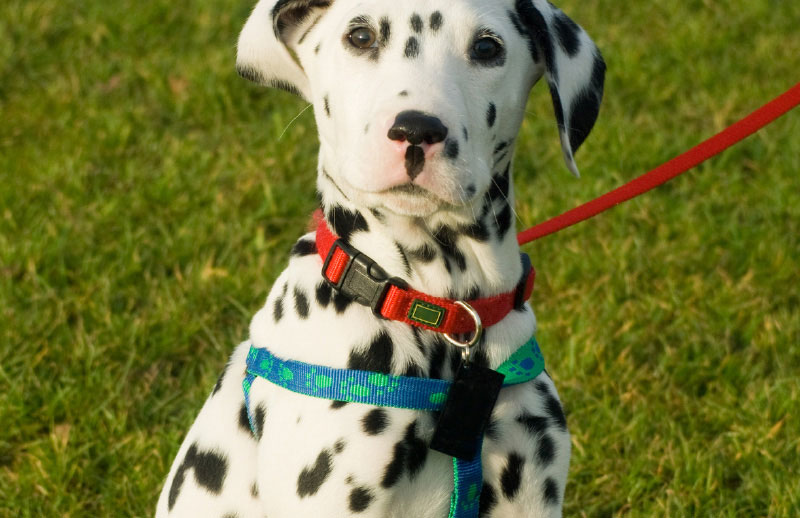
Lead
Your dog will need at least two different types of leads for their exciting first walks.
STANDARD LEAD : This should be long enough to comfortably allow your pup to walk on a “loose lead” – that is, just ahead or behind you. There should be a looped handle to give you a secure grip on your pup.
LONG LEAD : It’s recommended to also purchase a long lead while you are still perfecting your puppy’s recall. “Retractable” leads are not recommended, as they offer less control than long leads and can be dangerous to a young pup.
The sooner you can teach your puppy to get used to their harness or collar and to walk on lead, the easier it will be for them. It is advisable to have a name tag on your dog’s collar orharness with your phone number to help reunite you and your dog faster in case they are lost. Be sure to check your local regulations around ID tags and what information to provide on it. Your puppy should also be microchipped so that if their collar is removed and they are lost they can be easily returned to you. A microchip will also help identify your puppy if they are stolen and confiscated.
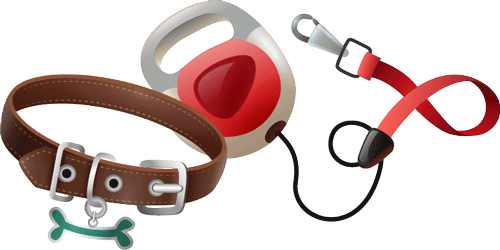

Bed
The all-important question of what type of bed to get your puppy! Bear in mind that puppies going through a teething process will inevitable chew whatever comes their way, avoid getting a very expensive bed. A good plastic dog bed with some comfortable blankets may be your best option at the start until your puppy stops teething and being destructive. Also with possible accidents, blankets are easier to wash regularly than a fur-lined dog bed for example. Practicality and being sensible at the early stages are the key. Never ever get a wicker basket for a young puppy as they can be a choking hazard if the pup is left unsupervised and chews on their bed.
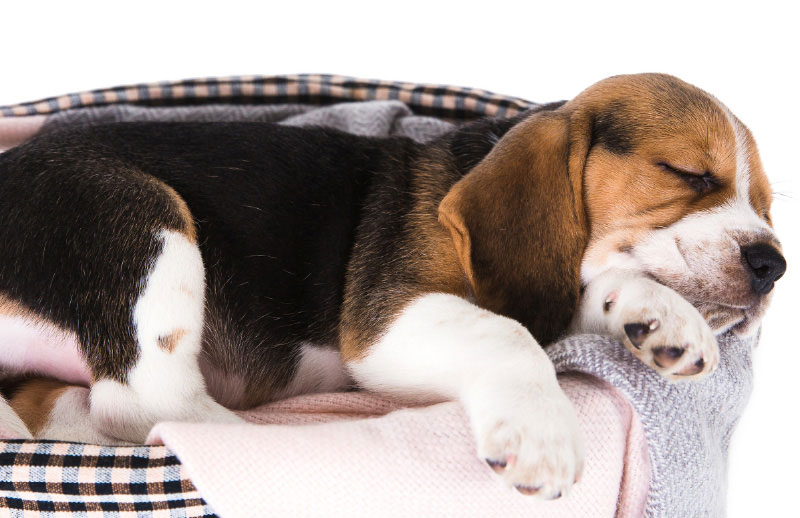

Puppy pen / Crate
A puppy pen can offer a puppy a safe space, not only for them to sleep but also to have time out from activities. Also, if you are going to be away for a short while and want to ensure that your puppy is safe and confined whilst you are away, a puppy pen will help. However, puppies should not be left on their own in a pen for more than a couple of hours (except when sleeping at night).
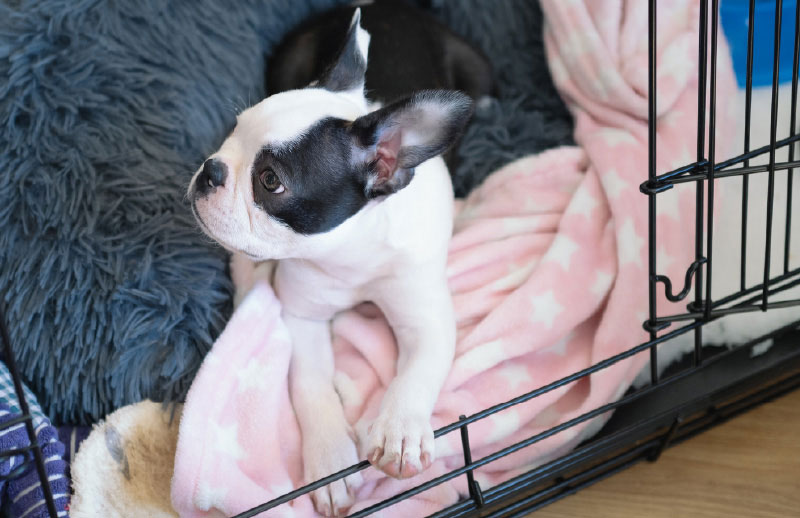

Pet travel carrier
A pet travel carrier is an advisable way to transport your puppy when in the car or on public transport and will ensure they are secure and safe.
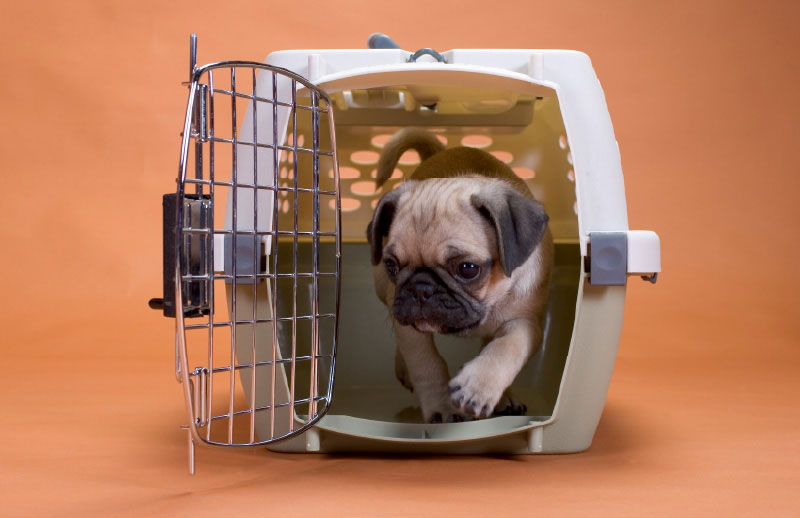

Grooming brush
As daily grooming is essential and recommended, ensure you get a brush for the correct type of coat for your puppy. Some brushes if used on the wrong type of coat, can be harmful for your puppy, e.g., using a brush to remove undercoat on a pup that does not have an undercoat or is short coated. Get advice from your breeder on what they use. Daily grooming allows you to check the pup for lumps or bumps and should be a relaxing time of bonding between the two of you.
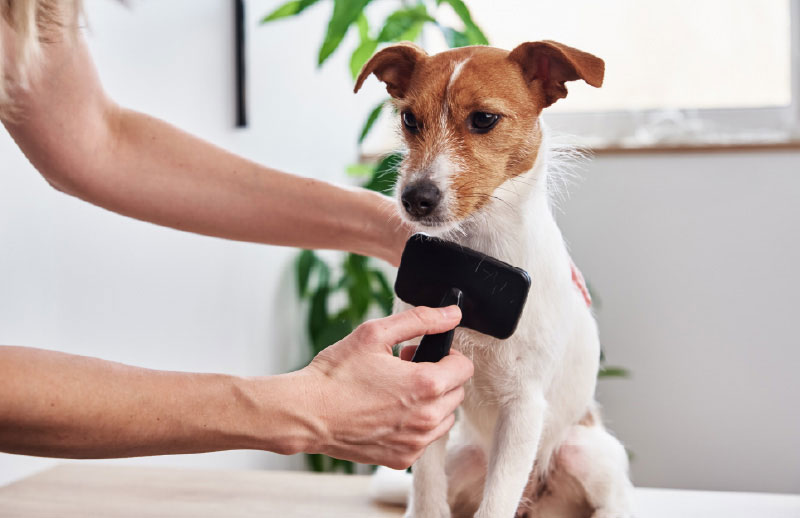

Dog toys
Another age-old debate on what is best. The simplest advice is to avoid toys that are cheap and poor quality as they are easily destroyed, costing you money, but more importantly they may be ingested by your puppy and cause harm to them. Better quality, longer lasting rubber toys are the best, as they will last and be safe for your puppy. Higher initial cost, but better for your pup and you! Do regularly checks of your pup’s toys to see their condition and remove those which could cause harm to your puppy. Bear in mind that some toys may be more suitable to one breed than to another and take into consideration the size of your puppy when buying toys.
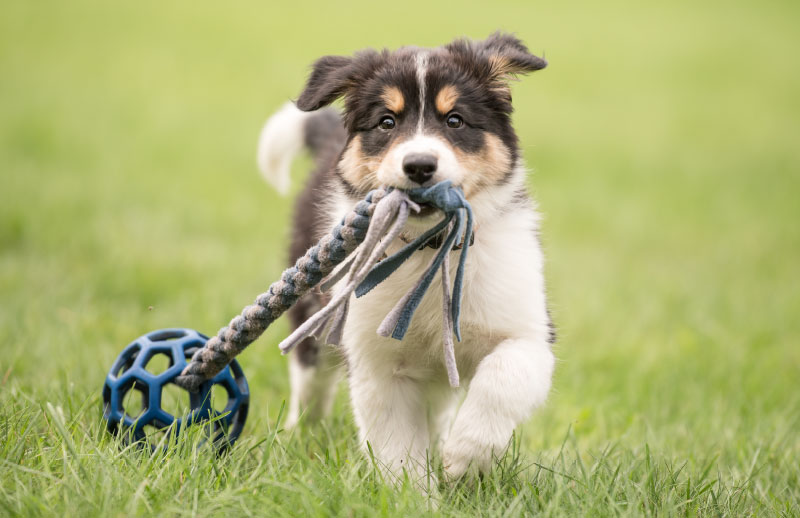

Puppy food
Again, to make this less traumatic to the puppy, the best thing to do is to continue to feed them the same food they received while with their breeder and if you must change their food then do it gradually as too many changes in a short time will be stressful and may even cause your puppy to go off its food. So, when in this new environment, at least the smell of the food is something that is familiar and comforting. Drastic sudden change can cause diarrhoea and sickness. Reputable breeders will provide you with a feeding guide which will state the type of food, quantities and feeding times. If there are no special feeding recommendations, choose a specific health-nutrition puppy growth diet, adapted to your puppy’s age, breed and size.
Always keep in mind that proper nutrition is crucial for the healthy development of a dog, especially at a younger age. Otherwise, unwanted health issues may easily occur.
And most importantly, your puppy should always be supervised when being fed, especially if there are other pet dogs in the home.
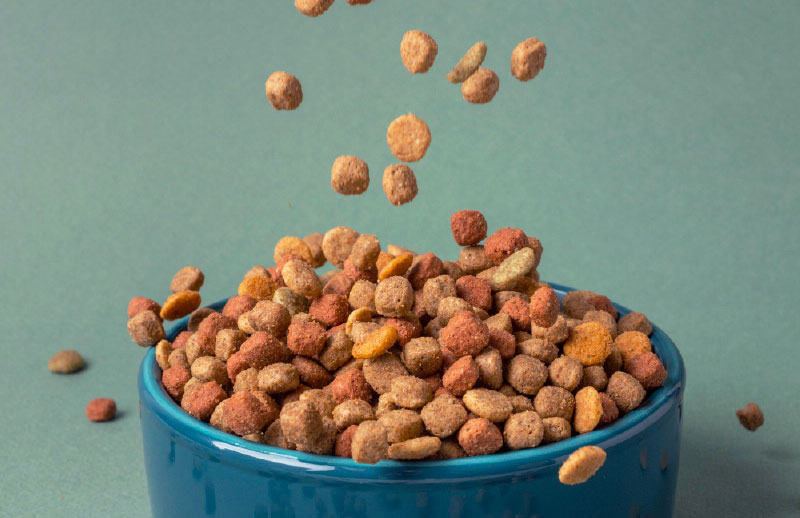

Puppy Pads
While you are in the process of toilet training your new puppy, it may help to use either disposable or washable puppy pads, especially for overnight use. These can be purchased from your local pet store or online. Your puppy will need to be trained to use the puppy pads with reward-based training.
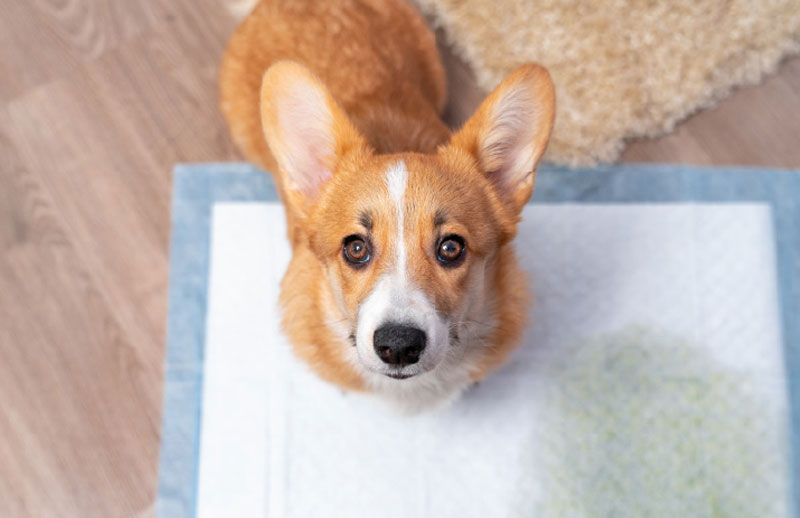
PREPARING YOUR HOME
After getting the essentials, getting your home ready for your pup’s arrival is the next crucial step, as there are many dangers for a puppy in your home, so making your pups living environment safe before they arrive is vital.
It is good practice to have a dedicated area in your home for your puppy so that they can adapt and learn the ropes in their new home. Allowing them to have free rein all around your house may require more work on your part to make your home puppy safe. Introducing them step by step to the other rooms in your home after they are familiar and comfortable with one is more sensible.
After deciding this, here are some questions to consider :
1. Where should your puppy eat and drink?
Choosing a dedicated spot and sticking to dedicated times will help form a routine.
2. Where should your puppy sleep?
It’s important to have a dedicated sleeping area for your puppy to rest, especially as they will sleep for the best part of the day when very young. A well-ventilated area that is not too cold or too hot, as well as being free of drafts is best. It might also help for your puppy to have a day bed location and a night one, but once decided, try not to keep switching the location as pup’s thrive best with routine and stability. For the daytime a spot in the house where they can also watch the goings on and not feel left out will help them adjust to their new home.
3. Where should your puppy go to the toilet?
Deciding on an area for your puppy to go to the toilet is also something to consider and for them to be trained for. Your puppy may need puppy pads initially as they learn about toileting. Although some puppies may be able to access the garden from the start. Dogs can be creatures of habit, so if trained young, they may stick to this location for life. Puppies should never be punished or told off if they toilet in the wrong area instead they should always be praised for going in the right area. It is important that puppies are not fearful of going to the toilet so training must be reward based and not punishment based. It is a myth that rubbing your dog’s nose in their poo if they have toileted inside your house and then putting them outside works, this is a punishment-based method and will only make your dog fearful of toileting in the future.
4. How should you puppy proof your home?
It is important to ensure all the rooms accessible to your pup are made safe. A puppy will tend to chew on anything they find in the early days, so check all visible electrical cables i.e., TV/light and hanging wires i.e. from an iron and ensure they can’t be accessed. Could your puppy get trapped or fall anywhere? Check windows, balconies, and staircases. Cleaning products or some household plants can cause intoxication. Be very careful not to leave out medicine or certain foods which can be dangerous or toxic for your puppy, such as chocolate, onions, grapes, sultanas, or salt. The use of a baby gate to stop your puppy from going up staircases or into rooms they are not allowed in can prove useful. This also creates boundaries whilst not shutting them away and allowing them to see you and know you are there.
5. How should you puppy proof your garden?
If your puppy is allowed into the garden, it’s essential to make sure there are not gaps in the fences or that gates won’t allow a small puppy to slip past and escape. Whilst it is not recommended for your puppy to be left unsupervised, a quick escape can still pose a risk. All fertilisers and garden chemicals need to be stored out of reach and safely locked away. This also includes recognising if your garden has any toxic plants or plants with thorns or anything that can harm your pup.
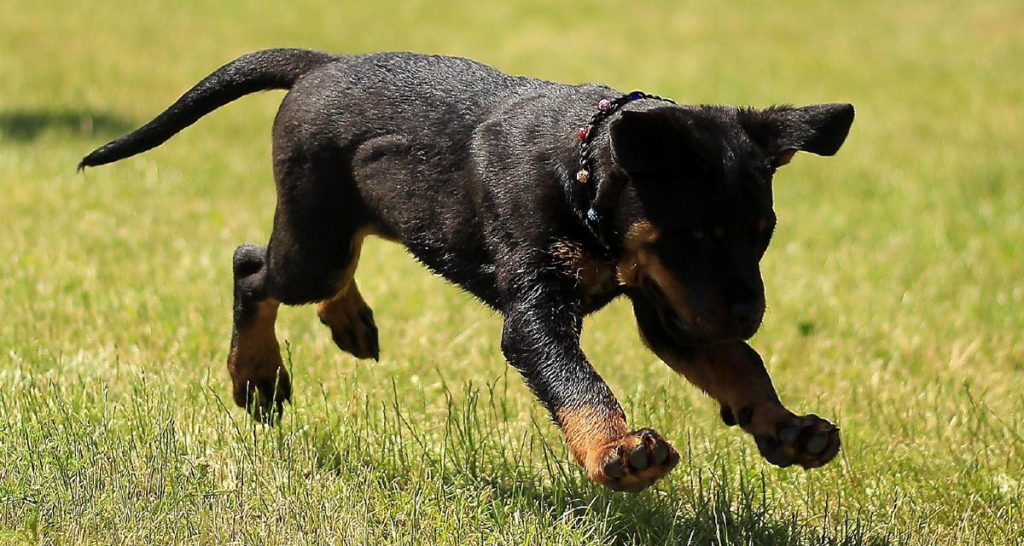
CARING FOR YOUR PUPPY
Essential Equipment
If you’re collecting your pup from the breeder, some essential items like a pet travel carrier, blanket/towel, water, and travel water bowl if it’s a longer journey, are advisable. Don’t forget to ask the breeder for all the pup’s relevant paperwork (microchip details, pedigree certificate, health tests, pet passport – if available and vaccination certificate). Also, some food in case you were not able to get the same brand the pup has been weaned on. Some breeders will provide bedding which the pup has used with familiar smells of their mother and litter mates. Save this for when you get home and not the journey in case there are any “accidents” in the car, and you need to wash this special bedding. The bedding can then be put in the puppy’s dog bed.
This is a big and exciting event for everyone including the pup. Pups usually take a few days after arrival to adjust, so don’t be anxious if they are subdued and don’t settle in immediately. Remember this is a totally new environment, they have left their mother and litter mates and you are new to them.
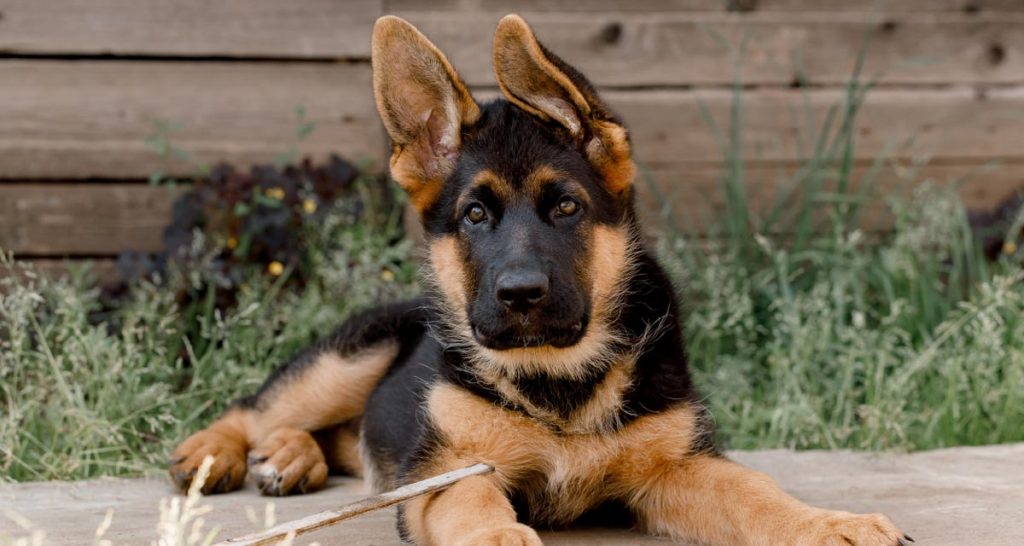
So, the following tips could prove handy:
- Try to keep your puppy in a quieter environment for the first few days.
- Allow them access to the pet carrier they travelled in or a puppy pen/crate as a source of comfort if they wish to go to that, ensure that they have easy access to their bed and food and water.
- If the pup is nervous, let them settle down and venture out at their pace. Do not force them to do things and try not to over handle them. Sitting with them and allowing them to come to you reassures them.
- Don’t forget to either put down puppy pads for the puppy to go to the toilet, accepting that there will be accidents initially with toileting and that reward-based training is the best way to teach your puppy where to toilet. Alternatively, if you have a secure garden ensure that you take them out regularly especially after your puppy has woken up or eaten or been actively playing so that they can go to the toilet outdoors.
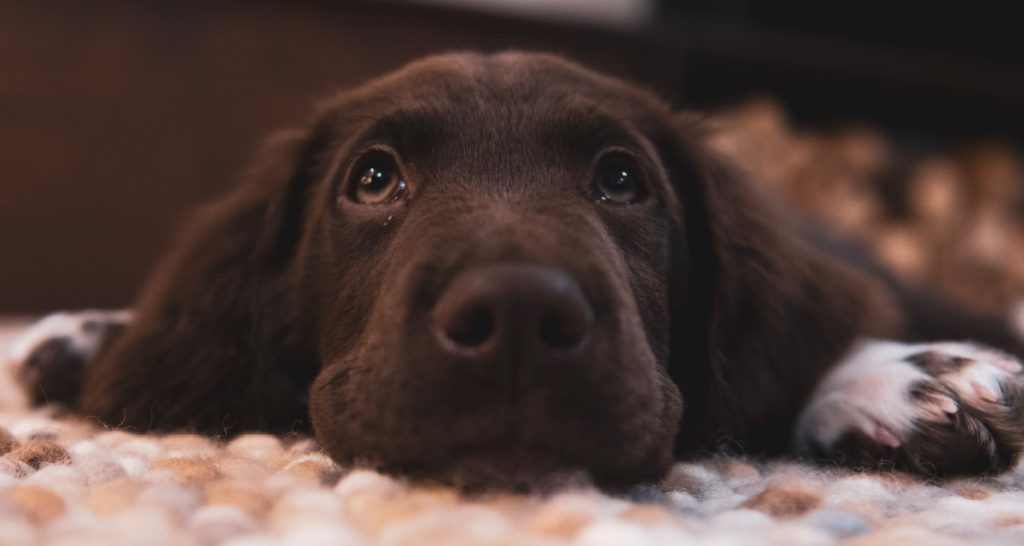
As mentioned above, decide where your pup will spend most of its time and stick to that location to settle your pup. Introduce them to other rooms gradually to avoid confusion, as they are suddenly in several new environments all at the same time. They also need a few days to get to know and trust you, so once they develop a bond with you, being exposed to other new stimuli is less daunting as they have you with them.
Only bring your puppy home when you can be at home with them to settle them in over time. No puppy should be left on their own initially, if you need to leave your puppy on their own it should be when they have settled in and only then for a few hours ensuring that they are in a safe and secure area with access to water and food. It can be very daunting for a puppy to be “abandoned” in a new environment and potentially lead to fearful behaviour in the future. These initial days are also crucial times for you and your pup to bond and this time is necessary. At the same time there is a fine line between training your puppy to be accepting when you are away and creating separation anxiety. Finding a balance is important, so start with short periods of separation even if you’re in another room of the house to avoid this dependency and get your puppy used to being on their own for short periods.
Introducing your pup to your children
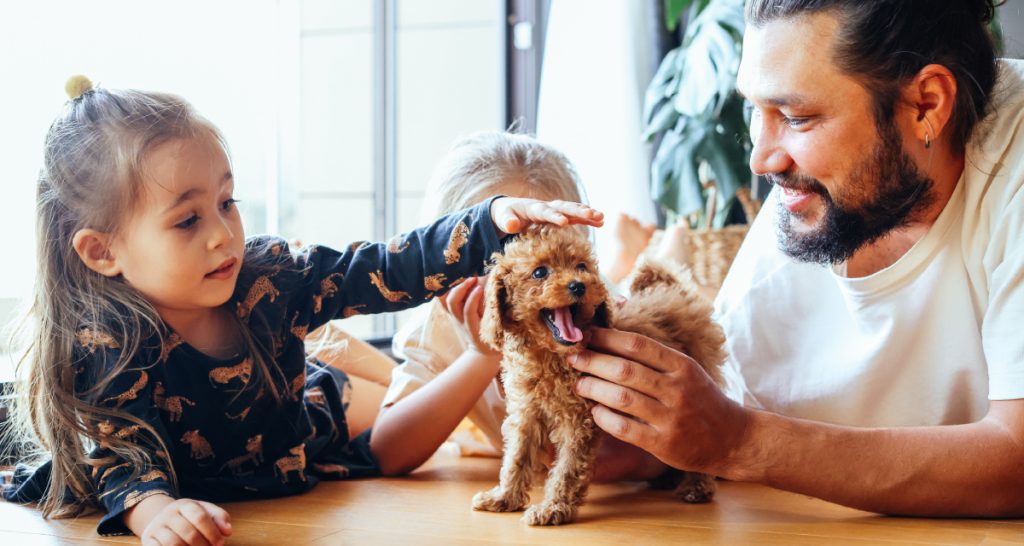
As mentioned above, decide where your pup will spend most of its time and stick to that location to settle your pup. Introduce them to other rooms gradually to avoid confusion, as they are suddenly in several new environments all at the same time. They also need a few days to get to know and trust you, so once they develop a bond with you, being exposed to other new stimuli is less daunting as they have you with them.
Only bring your puppy home when you can be at home with them to settle them in over time. No puppy should be left on their own initially, if you need to leave your puppy on their own it should be when they have settled in and only then for a few hours ensuring that they are in a safe and secure area with access to water and food. It can be very daunting for a puppy to be “abandoned” in a new environment and potentially lead to fearful behaviour in the future. These initial days are also crucial times for you and your pup to bond and this time is necessary. At the same time there is a fine line between training your puppy to be accepting when you are away and creating separation anxiety. Finding a balance is important, so start with short periods of separation even if you’re in another room of the house to avoid this dependency and get your puppy used to being on their own for short periods.
A puppy is not a toy, but a member of the family. Sudden movements, shrilled screams of excitement or even squeezing a puppy too tightly can frighten and harm the pup. Explain to your children that puppies have very sensitive hearing so calm indoor voices even during play is necessary. With younger children it is recommended they are not left unattended. When your pup arrives it’s important to sit your children down and calmly introduce the pup to them. Discourage them from carrying the pup around as they may hurt the pup if they accidentally drop the puppy.
Parents should teach their children the proper way to hold and pat the puppy. The puppy should never be tugged on its tail or ears or be lifted by the scruff of its neck (except by their mother). Likewise, parents should also ensure that young pups do not nip their children even during play and enforce bite inhibition from a young age with reward-based training. It is also important for both your pup and children to have time out from each other and rest periods to prevent the pup from feeling overwhelmed.
Introducing your pup to your other pets
It is important that your new pup and your other pets are given time to get to know each other so that they live in harmony together. Introductions should be gradual and fully supervised so that both your pup and other pets feel safe and able to withdraw if they are uncomfortable. If other pet dogs react by barking and growling at the new arrival, they should be removed from the room but not punished, they should be reintroduced later and only for a limited period, this should be repeated until they begin to accept the new pup. It will take time sometimes weeks for everyone to adjust to a new arrival. Always keep an eye during the initial stages and allow older pets to be able to be on their own and not forced to be with the new pup. It’s also normal that a younger pup will need more attention, so extra attention should be given to existing pets, as they adapt to the new member of the family.
Introducing your pup to your cat
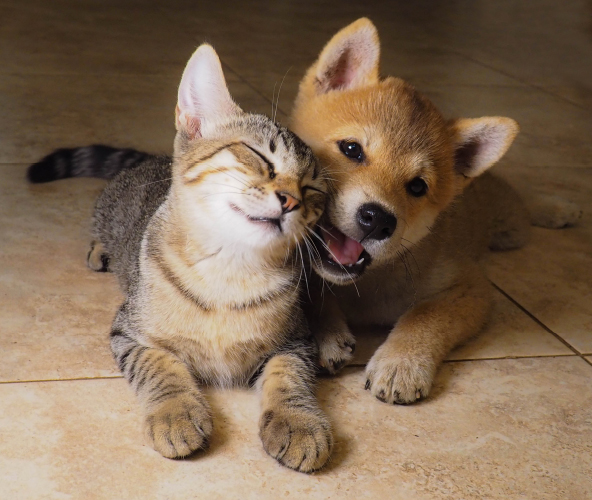
Cats will tend to observe at a distance before they have contact, so allow this natural process. DO NOT force your cat to meet your new pup and always ensure that your cat can escape and have a safe place away from the pup when needed. Let them develop the relationship at their own pace. The pup also needs to learn to respect your cat and this may involve learning the hard way, so initial periods together should be fully supervised so that you can intervene if necessary.
Introducing your pup to your older dog
If your existing older dog is well socialised, then accepting a new pup will be a lot easier. Dogs are social animals, so they are usually happy to live together and become friends after initial introductions. If you are not sure how your older dog reacts to other dogs in his home, introduce them in a neutral place outside your home so the older dog will not be territorial. Ensure introductions are gradual and fully supervised and allow your existing dog time out if needed to adapt to the new family member. Each dog should be fed in their own bowl and separately away from each other. Also with toys, it’s advisable to get some new toys for your pup so that your older dog does not feel his toys are being taken away. And give extra attention to your existing dog during this time while they adjust to the new arrival.
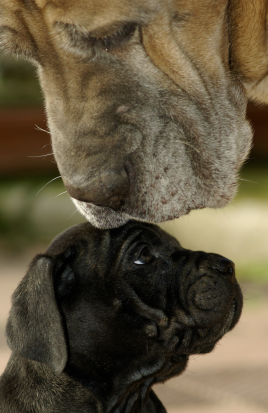
Playing with and handling your puppy
Play is important for a puppy’s physical and mental development. Through play puppies can exercise and develop muscles, agility, and strength. By playing games that require your puppy to seek out hidden toys or treats, follow scent trails, or make choices, your puppy learns to use their brain and senses. Playing with your puppy regularly will also help to establish a strong bond between you and your pup. Always ensure that you do not overexert your pup during play and that there is no rough handling. As a rough guide, play with your puppy for at least 30 minutes a day, in addition to giving your pup 20 minutes of free exercise twice a day. A bored puppy is a destructive puppy. Play isn’t just a fun part of living with your dog, it’s an essential feature of how we all stay emotionally and physically healthy. So, it’s important for your physical and social wellbeing as well as your pups to play with your dog daily. As part of a pup’s socialisation, they should be used to being gently handled and this should be done daily so they associate handling with love and security. This will also make vet visits or visits to the groomers a more pleasant experience. Daily brushing is also another great way to build a bond between yourself and your new pup.
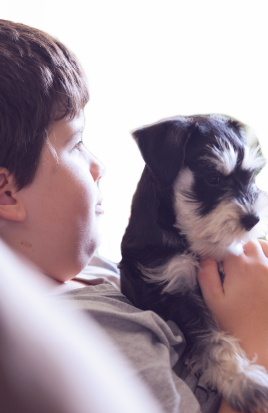
Toilet training
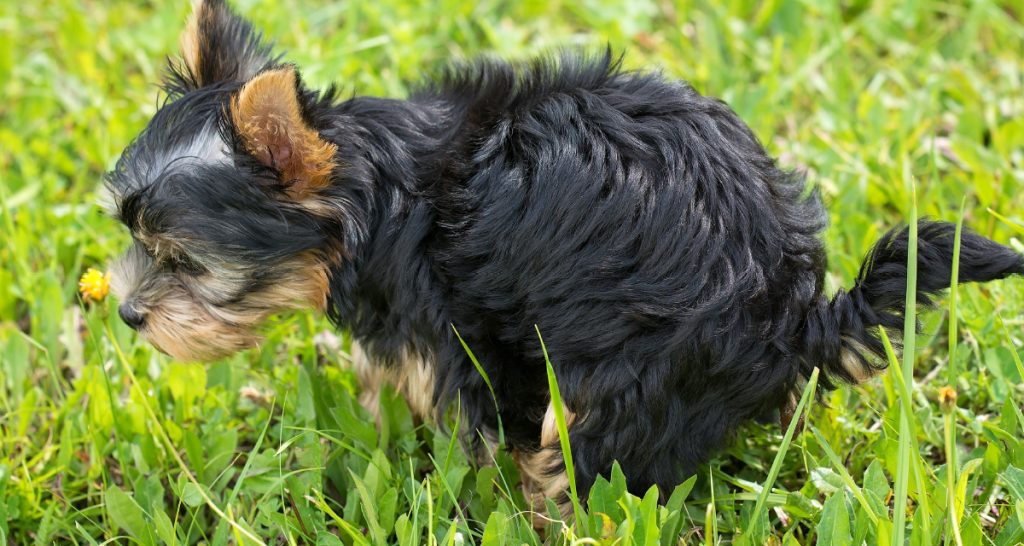
To toilet train your puppy, your pup will need to take outside regularly (at least every couple of hours). Puppies have small and very weak bladder control and will need to relieve themselves regularly throughout the day. There is a fairly set pattern to this: immediately after waking up, after play and after eating. Always choose the same place in the garden or in the house if using puppy pads/a puppy litter tray and take the pup there after they wake in the morning and when
they finish eating and playing.
Stay with your pup until they have done their toileting and then give them plenty of praise. It is essential that they link th edesignated area in your garden or their puppy pad for toileting with reward. But please remember that being little, accidents will happen. If you catch your pup in the act, simply take your pup outside to the designated toilet area or to their puppy pad and then praise them once they are done.
Shouting at your pup if they go to the toilet in the wrong place or rubbing their noses in it, does not teach them anything except fear and confusion which they will then go onto associate with going to the toilet. Reward based training is the best way to train your puppy.
Walking your puppy
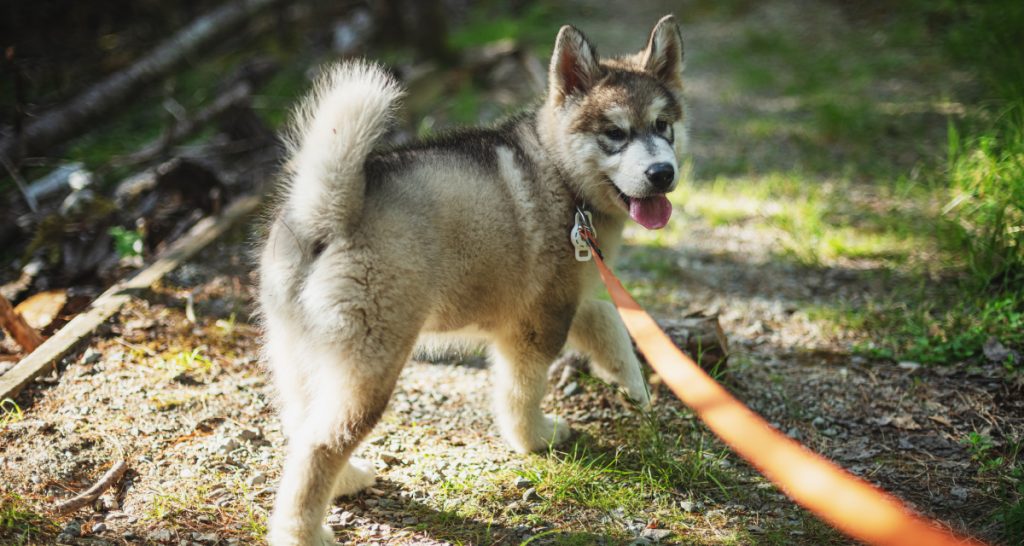
Train your pup to walk on a lead but do not take your young pup for strenuous or very long walks especially over difficult terrain. It does not make them healthy but can stunt and affect their growth. Pups up to the age of 12 months should be given free run/play until they are tired and not forced to walk or jog for excessively long periods. Their tendency is to keep following you and not stopping when tired.
Over-exercising puppies can negatively impact on their musculoskeletal development, and this is of particular concern in large and giant breed puppies. Some of the large and giant dog breeds can continue to grow up until 18–24 months of age. Please get the advice from your veterinarian, breeder, or breed club as to how much and when to start seriously exercising
Healthcare for your puppy
Most breeders will give you lots of advice on how to care for the health of your pup that will be breed specific, but in case they don’t, here are some general tips. For all medical advice, you should consult your local vet.
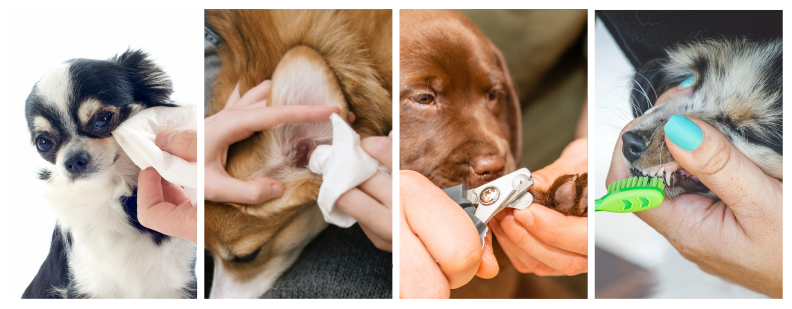
Eyes, Ears, Nails and Teeth
Besides daily grooming, pay attention to the eyes, ears, nails, and teeth of your pup too.
Eyes
The correct way to clean their eyes is to use wipes or eye solution recommended by a vet. Be always gentle and start from a young age, by making it part of their grooming routine, it will make it easier to carry out.
Ears
Checking your pup’s outer ear canal is also important to ensure that it’s dry and has no excessive wax build up. This is particularly important with dogs with drop ears where the moisture helps the build-up of wax and encourages ear mites. Use a recommended ear solution and follow the instructions very carefully. Never go deeper than what your eye can see. Clean the outer part that is visible and never use cotton buds. Cotton wool and a soft cloth is always the best. If in doubt or if this concerns you get a vet or professional groomer to help you.
Nails
Keeping your pup’s nails short is also an important part of the grooming routine. Long nails make it uncomfortable for pups to walk and can lead to ingrown nails which are painful and may require surgery to correct. But cutting your pup’s nails is a delicate procedure as the nails have a live vein in them and cutting them without proper knowledge can lead to pain for your pup. So, it may help to get your vet to trim your pups’ nails or seek the services of a professional groomer. Doing them regularly and from a young age will make this process which most dogs dislike, less stressful.
Teeth
Between the ages of 3 and 6 months your pup will get their permanent set of adult teeth, so dental care should only start after this period. With several regimes available including brushing, pastes, dental chews, and raw alternatives, find a way that best suits you and your pup. But take oral hygiene seriously as removing plaque and keeping healthy gums will ensure your pup has a long and healthy life, especially as he grows up. Poor oral hygiene can lead to more serious health issues that will affect your dog later in life. Get proper advice from your vet and stick to a routine for the life of your puppy.
Professional Groomers
Even if you don’t own a dog with lots of coat, a professional groomer can help with things like ear cleaning, nail trimming and bathing. Pups with a coat will need grooming, so it is important to get them accustomed to this process from a young age.
Anal Sacs/Glands
If you see that your puppy is rubbing their bottom along the ground, this may indicate that your pup has a problem with their anal sacs. The glands may have become swollen with liquid leading to irritation and pain, if is recommended that you take your puppy to your vet to have their glands emptied. This is a straightforward procedure that can be done relatively quickly without surgical intervention.
Worming and flea treatment
To keep your pup healthy, it is important to regularly treat them for parasites. Both internal (worms) and external (fleas and ticks) can have a negative impact on your dog’s health. Usually, puppies must be treated for fleas, ticks, and worms monthly up until 6 months of age and then regularly for both. The dosage of the treatment will depend on the size and age of your dog. Contact your veterinarian to get the right medication.
Neutering/Spaying
If you have no intentions to breed, the safest and most responsible thing to do is to neuter your pup, this can be done at 6 months of age. Neutering and spaying has many benefits including eliminating the risk of certain types of cancer as well as other diseases in dogs. It also helps to reduce the risk of marking behaviour in male dogs and avoids having to deal with a female dog coming into heat.
Registering with your local vet
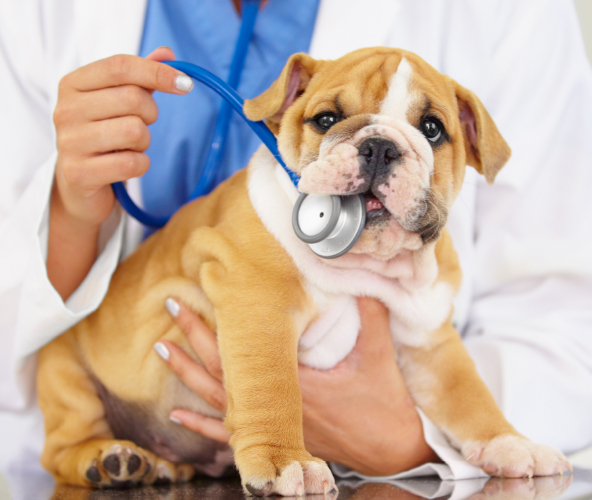
Register your puppy with a local vet and have your pup checked over usually a week or so after the pup settles into you home. This is so your vet knows your pup and that your pup will be registered at their clinic as a patient. Show your vet the pup’s vaccination card so that they are aware of the vaccinations and deworming treatment already done by the breeder. They will then be able to advise you when the next vaccination and worming is due. Routine healthcare and vaccinations are very important and should begin when your puppy is young and be maintained throughout your pup’s lifetime. If ever in doubt, seek veterinary advice. This initial visit also allows your pup to get accustomed to being handled by a vet in this clinical environment.
Training your puppy
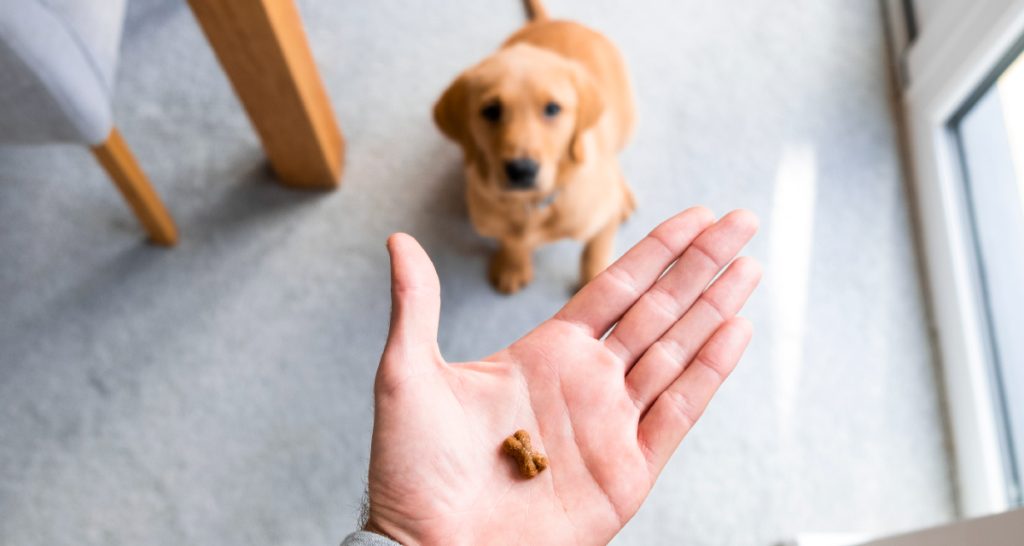
Veterinary treatment can be expensive, particularly when you least expect it, so it’s worth considering taking out pet insurance if that is available in your country. Good breeders almost always subscribe to an insurance scheme and will usually offer six to eight weeks free insurance cover when selling their puppies. But it is up to you to renew the policy after this time and possibly benefit from a discount if you continue with the initial breeder insurance.
Reward based training
Reward-based training involves the use of rewards such as praise, treats and play to reinforce desired behaviours, while ignoring unwanted behaviours. In theory, your puppy will associate the behaviour it shows when rewarded with positive emotions, leading to your puppy displaying the desired behaviour more frequently. Unwanted behaviour is simply ignored and not punished. This approach supports a healthy and trusting owner-pet bond.
Puppy Training classes
A well-trained dog will come to you when called and will respond to such commands as “sit” or “down” and will not pull on the lead. There are many training videos out there, but we encourage you to find a puppy training class close to your home that uses reward-based methods where you can enrol your pup for classes. Not only will it be a great way to learn how to train your pup with the guidance of a professional, but it will also help to socialise your pup with other pups (dogs) and people.
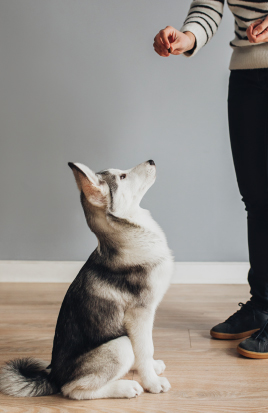
Socialisation
Socialisation refers to the learning process that a puppy must undergo to learn key life skills which ensure that they are able to cope with their environment. It is also the process of learning to behave in a way that is acceptable to society. Puppies can begin socialisation classes as early as 8 weeks, but socialisation begins at a much earlier stage. A good breeder will positively support their puppy’s behavioural development by ensuring early socialisation. Furthermore, having a well-adjusted and confident dog can even go as far as to save their life one day, as poor socialisation can lead to behavioural problems later in life.
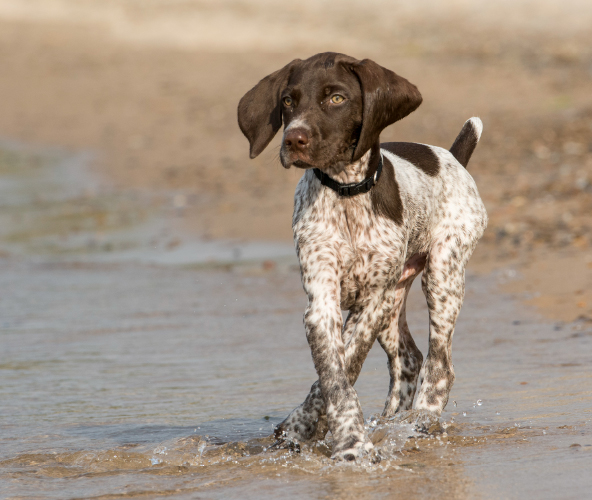
How do you socialise your pup? By exposing your pup to a wide variety of different experiences while they are young.
Typically, new pups should be exposed to:
- Unfamiliar people (different ages/gender/appearances)
- Different clothes: hats/glasses/gloves
- Other pets/animals
- Vehicles/public transport/road traffic
- Different indoor environments/Objects: stairs/hoover/washing machine
- Different outdoor environments: urban/parks/woods/beaches
- Body handling (ears, paws, tail, teeth)
- Different types of flooring and ground surfaces
- Common neighbourhood objects like street signs, bicycles, cars, strollers, skateboards
Try your best to make their experiences good ones! As socialisation needs to be positive, find ways to make sure your pup enjoys the new things they come across, by using treats, toys, and plenty of praise. If your pup has a negative experience during socialisation, this can make them nervous when they come across the same thing later in life, or it can even result in more generalised fears. If your pup seems anxious or afraid at any point, remove them from the situation and take them to a place where they seem calm and happy. Do NOT force them to “get over it” as this will increase their fear. Try the experience again on another day, staying positive and gently easing your pup into the situation until they are comfortable.
Everything will be new to your pup when they’re young, so it’s common place for them to be overwhelmed. Make sure you introduce new things gradually. Avoid introducing too many new experiences in one go and spread these experiences out over several days, aiming for short, positive experiences which can be repeated until your pup is comfortable and happy with them.
Register for a puppy socialisation class too, as that will help guide you in areas you find challenging with proper professional guidance. It also allows you to meet other puppy owners and get tips and hints whilst finding playmates for your pup. Socialisation is a crucial process that has a limited window of time, so it’s essential you don’t miss it or face having a dog with behavioural issues later in life.
Behavioural problems
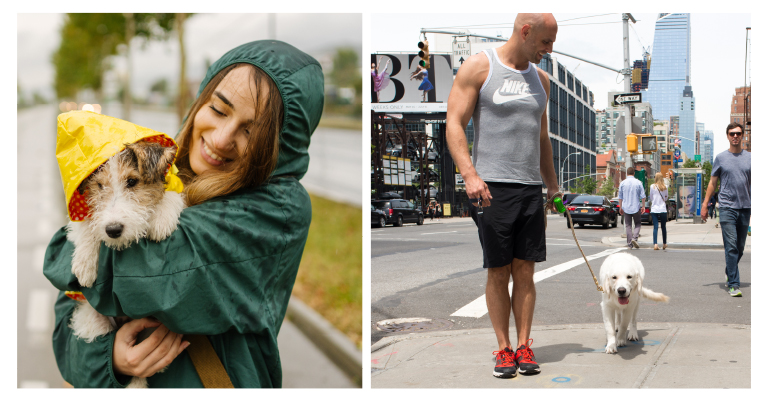
It is important to address behavioural issues as soon as they become known. Behavioural issues can be the first indicator of illness or other causes of decreased welfare. It is therefore important that if your dog is suffering from a behavioural issue that you first seek veterinarian advice in case it is a medical issue. Your veterinarian will also be able to advise you on the best course of action if your dog is physical fit but has a behavioural problem. A professional dog behaviourist can also be consulted to help address the issue providing they use reward-based methods. Behavioural problems often stem from a dog not being properly socialised earlier in life and most issues can be addressed with a proper behavioural treatment plan, reward-based training, and patience.

